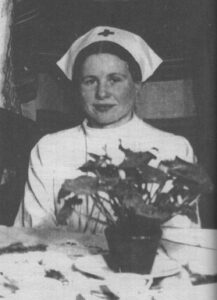
Not many people know the name Irena Sendler. There are no statues of her in local parks or schools named in her honor. Even after Yad Vashem–Israel’s official memorial and organization dedicated to preserving the memory of the Holocaust–publicly recognized her bravery and service in 1965, it took a group of Kansas high school drama students in 1999 to truly bring her story to life.
Irena was born on February 15, 1910. She grew up in Otwock, Poland, a town about 15 miles from the Jewish community in Warsaw. Her father was the local doctor and one of the few practitioners at the time who would treat Jewish patients. His motto was, “jump into the water to save someone drowning, whether or not you can swim.” Growing up around this mentality, Irena began to adopt it herself, becoming an avid advocate for social justice.
In the early stages of German occupation in Poland, Irena worked for the Warsaw Social Welfare Department at state-run canteens. On the surface, these canteens provided basics like food, clothing, and financial aid, but behind the scenes, they also helped to supply the Jewish community with false identities and documentation. Those who received new identities were taught mass and other mannerisms necessary to pass themselves off as Catholic instead of Jewish.
In 1940, the Germans sealed off Warsaw into a Jewish ghetto, confining over 400,000 Jews to just a few city blocks. Not long after, aiding Jews was declared punishable by death. This law was harshly enforced in Poland, especially, extending death not just to the individual responsible for the aid, but their entire family as well. Despite the threat, Irena continued to work on the Jews’ behalf, her passion and dedication only increasing after witnessing Dr. Janusz Korczak, a beloved pediatrician, author, and orphanage owner carted off to a death camp with his 200 wards.
Afraid the ghetto would be overrun with typhus and create an outbreak beyond its borders, the Germans allowed social workers in to monitor and control the spread of disease. Her position within the Social Welfare Department allowed Irena to enter the ghetto as one of these social workers. In an official capacity, she could only enter to conduct sanitary inspections, but each time she went into the ghetto, Irena snuck in contraband including food, clothing, and medical supplies. She also worked with the other social workers to sneak children out, hiding them in medical bags and ambulances to keep them from being discovered. If they awoke and began to cry as Irena passed German soldiers, the dog she always took with her would bark to cover the noise. Once they were out, the children were hidden in homes, churches, and convents. Irena kept track of them all, recording their names, aliases, and descriptions in the hopes she could help reunite them with their families after the war. She hid this list in a glass jar beneath an apple tree near one of the German barracks.
In 1943, someone reported Irena to the Germans. She was caught and tortured, her legs and feet broken, but she refused to give up any information. They ordered her executed, but the resistance network she was working for bribed the guards and helped her escape. Irena went into hiding to recover from her time with the Germans and, under a new identity, went back to Warsaw. She took a nursing position with the local hospital and continued her work, caring for and hiding Jews.
Moved by Irena’s story, a group of high school students researched and wrote a play based on her life. They called it Life in a Jar, and, upon learning Irena was still alive at the time of its creation, sent her a copy in her native language. Adapted by other schools and organizations, Life in a Jar was performed on stage over 200 times worldwide and turned into a film. As news of her story spread near and after her death, Irena was publicly recognized with several awards and memorial plaques in her honor.
Before her death in 2008, Irena was reunited with several of the Jewish children she helped to save. Their tear-filled reunion was one of hope and love as they were able to personally thank the woman who saved their lives.
-Emily VanderBent
Junior Girl
Girl Museum Inc.
